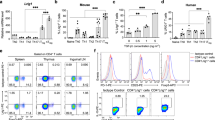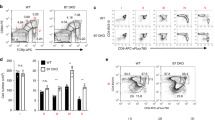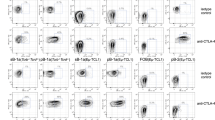Abstract
CD25+CD4+ regulatory T cells in normal animals are engaged in the maintenance of immunological self-tolerance. We show here that glucocorticoid-induced tumor necrosis factor receptor family–related gene (GITR, also known as TNFRSF18)—a member of the tumor necrosis factor–nerve growth factor (TNF-NGF) receptor gene superfamily—is predominantly expressed on CD25+CD4+ T cells and on CD25+CD4+CD8− thymocytes in normal naïve mice. We found that stimulation of GITR abrogated CD25+CD4+ T cell–mediated suppression. In addition, removal of GITR-expressing T cells or administration of a monoclonal antibody to GITR produced organ-specific autoimmune disease in otherwise normal mice. Thus, GITR plays a key role in dominant immunological self-tolerance maintained by CD25+CD4+ regulatory T cells and could be a suitable molecular target for preventing or treating autoimmune disease.
This is a preview of subscription content, access via your institution
Access options
Subscribe to this journal
Receive 12 print issues and online access
$209.00 per year
only $17.42 per issue
Buy this article
- Purchase on Springer Link
- Instant access to full article PDF
Prices may be subject to local taxes which are calculated during checkout







Similar content being viewed by others
References
Shevach, E. M. Regulatory T cells in autoimmunity. Annu. Rev. Immunol. 18, 423–449 (2000).
Sakaguchi, S. Regulatory T cells: key controllers of immunologic self-tolerance. Cell 101, 455–458 (2000).
Maloy, K. J. & Powrie, F. Regulatory T cells in the control of immune pathology. Nature Immunol. 2, 816–822 (2001).
Sakaguchi, S., Sakaguchi, N., Asano, M., Itoh, M. & Toda, M. Immunologic self-tolerance maintained by activated T cells expressing IL-2 receptor alpha-chains (CD25). Breakdown of a single mechanism of self-tolerance causes various autoimmune diseases. J. Immunol. 115, 1151–1164 (1995).
Asano, M., Toda, M., Sakaguchi, N. & Sakaguchi, S. Autoimmune disease as a consequence of developmental abnormality of a T cell subpopulation. J. Exp. Med. 184, 387–396 (1996).
Suri-Payer, E., Amar, Z. A., Thornton, A. M. & Shevach, E. M. CD4+ CD25+ T cells inhibit both the induction and effector function of autoreactive T cells and represent a unique lineage of immunoregulatory cells. J. Immunol. 160, 1212–1218 (1998).
Shimizu, J., Yamazaki, S. & Sakaguchi, S. Induction of tumor immunity by removing CD25+ CD4+ T cells: a common basis between tumor immunity and autoimmunity. J. Immunol. 163, 5211–5218 (1999).
Sakaguchi, S. et al. Immunologic tolerance maintained by CD25+ CD4+ regulatory T cells: their common role in controlling autoimmunity, tumor immunity, and transplantation tolerance. Immunol. Rev. 182, 18–32 (2001).
Takahashi, T. et al. Immunologic self-tolerance maintained by CD25+ CD4+ naturally anergic and suppressive T cells: induction of autoimmune disease by breaking their anergic/suppressive state. Int. Immunol. 10, 1969–1980 (1998).
Thornton, A. M. & Shevach, E. M. CD4+ CD25+ immunoregulatory T cells suppress polyclonal T cell activation in vitro by inhibiting interleukin 2 production. J. Exp. Med. 188, 287–296 (1998).
Itoh, M. et al. Thymus and autoimmunity: production of CD25+ CD4+ naturally anergic and suppressive T cells as a key function of the thymus in maintaining immunologic self-tolerance. J. Immunol. 162, 5317–5326 (1999).
Salomon, B. et al. B7/CD28 costimulation is essential for the homeostasis of the CD4+ CD25+ immunoregulatory T cells that control autoimmune diabetes. Immunity 12, 431–440 (2000).
Read, S., Malmstrom, V. & Powrie, F. Cytotoxic T lymphocyte-associated antigen 4 plays an essential role in the function of CD4+ CD25+ regulatory cells that control intestinal inflammation. J. Exp. Med. 192, 295–302 (2000).
Takahashi, T. et al. Immunologic self-tolerance maintained by CD4+ CD25+ regulatory T cells constitutively expressing cytotoxic T lymphocyte-associated antigen 4. J. Exp. Med. 192, 303–310 (2000).
Nakamura, K., Kitani, A. & Strober, W. Cell contact-dependent immunosuppression by CD4+ CD25+ regulatory T cells is mediated by cell surface-bound transforming growth factor β. J. Exp. Med. 194, 629–644 (2001).
Jordan, M. S. et al. Thymic selection of CD4+ CD25+ regulatory T cells induced by an agonist self-peptide. Nature Immunol. 2, 301–306 (2001).
Nocentini G., L. et al. A new member of the tumor necrosis factor/nerve growth factor receptor family inhibits T cell receptor-induced apoptosis. Proc. Natl Acad. Sci. USA. 94, 9216–9221 (1997).
Kwon, B. et al. Identification of a novel activation-inducible protein of the tumor necrosis factor receptor superfamily and its ligand. J. Biol. Chem. 274, 6056–6061 (1999).
Gurney, A. L. et al. Identification of a new member of the tumor necrosis factor family and its receptor, a human ortholog of mouse GITR. Curr. Biol. 9, 216–218 (1999).
Locksley, R. M., Killeen, N. & Lenardo, M. J. The TNF and TNF receptor superfamilies: integrating mammalian biology. Cell 104, 487–501 (2001).
Nagata, S. & Golstein, P. The Fas death factor. Science 267, 1449–1456 (1995).
Kumanogoh, A. et al. Increased T cell autoreactivity in the absence of CD40-CD40 ligand interactions: a role of CD40 in regulatory T cell development. J. Immunol. 166, 353–360 (2001).
Bansal-Pakala, P., Jember, A. G. & Croft, M. Signaling through OX40 (CD134) breaks peripheral T-cell tolerance. Nature Med. 7, 907–912 (2001).
Watt T. H. & M. A. DeBenedette . T cell co-stimulatory molecules other than CD28. Curr. Opin. Immunol. 11, 286–293 (1999).
Kwon, B., Youn, B. S. & Kwon, B. S. Functions of newly identified members of the tumor necrosis factor receptor/ligand superfamilies in lymphocytes. Curr. Opin. Immunol. 11, 340–345 (1999).
Toh, B. H., van Driel, I. R. & Gleeson, P. A. Pernicious anemia. New Eng. J. Med. 337, 1441–1448 (1997).
Weinberg, A. D., Vella, A. T. & Croft, M. OX-40: life beyond the effector T cell stage. Semin. Immunol. 10, 471–480 (1998).
Hendriks, J. et al. CD27 is required for generation and long-term maintenance of T cell immunity. Nature Immunol. 1, 433–440 (2000).
Thompson, C. B. & Allison, J. P. The emerging role of CTLA-4 as an immune attenuator. Immunity 7, 445–450 (1997).
Bluestone, J. A. Is CTLA-4 a master switch for peripheral T cell tolerance? J. Immunol. 158, 1989–1993 (1997).
Kuniyasu, Y. et al. Naturally anergic and suppressive CD25+ CD4+ T cells as a functionally and phenotypically distinct immnoregulatory T cell subpopulation. Int. Immunol. 8, 1145–1155 (2000).
Sakaguchi, S. & Sakaguchi, N. Role of genetic factors in organ-specific autoimmune diseases induced by manipulating the thymus or T cells, and not self-antigens. Rev. Immunogenet. 2, 147–153 (2000).
Sotomayor, E. M. et al. Conversion of tumor-specific CD4+ T-cell tolerance to T-cell priming through in vivo ligation of CD40. Nature Med. 5, 780–787 (1999).
Melero, I. et al. Monoclonal antibodies against the 4-1BB T-cell activation molecule eradicate established tumors. Nature Med. 3, 682–685 (1997).
Weinberg, A. D. et al. Engagement of the OX-40 receptor in vivo enhances antitumor immunity. J. Immunol. 164, 2160–2169 (2000).
Hara, M. et al. IL-10 is required for regulatory T cells to mediate tolerance to alloantigens in vivo. J. Immunol. 166, 3789–3796 (2001).
Taylor, P. A., Noelle, R. J. & Blazar, B. R. CD4+ CD25+ immune regulatory cells are required for induction of tolerance to alloantigen via costimulatory blockade. J. Exp. Med. 193, 1311–1318 (2001).
Hall, B. M., Pearce, N. W., Gurley, K. E. & Dorsch, S. E. Specific unresponsiveness in rats with prolonged cardiac allograft survival after treatment with cyclosporine. III. Further characterization of the CD4+ suppressor cell and its mechanisms of action. J. Exp. Med. 171, 141–157 (1990).
Shahinian, A. et al. Differential T cell co-stimulatory requirements in CD28-deficient mice. Science 261, 609–612 (1993).
Takabe, Y. et al. SRα promoter: an efficient and versatile mammalian cDNA expression system composed of the simian virus 40 early promoter and the R-U5 segment of human T-cell leukemia virus type 1 long terminal repeat. Mol. Cell. Biol. 8, 466–472 (1998).
Suda, T., Takahashi, T., Golstein, P. & Nagata, S. Molecular cloning and expression of the Fas ligand, a novel member of the tumor necrosis factor family. Cell 75, 1169–1178 (1993).
Kubota, H., Yokota, S., Yanagi, H. & Yura, T. Transcriptional regulation of the mouse cytosolic chaperonin subunit gene Ccta/t-complex polypeptide 1 by selenocysteine tRNA gene transcription activation factor family zinc finger proteins. J. Biol. Chem. 275, 28641–28648 (2000).
Sakaguchi, S., Fukuma, K., Kuribayashi, K. & Masuda, T. Organ-specific autoimmune diseases induced in mice by elimination of T-cell subset. I. Evidence for the active participation of T cells in natural self-tolerance: deficit of a T-cell subset as a possible cause of autoimmune disease. J. Exp. Med. 161, 72–86 (1985).
Acknowledgements
We thank T. Suda, N. Hosokawa, H. Kubota, and T. Nomura for technical advice; T. Maruyama, M. Matsumoto and K. Ishihara for the reagents and cell lines; E. Moriizumi for histology; and K. Wood, S. Hori and T. Nomura for critically reading the manuscript. Supported by grants-in-aid from the Ministry of Education, Science, Sports and Culture, the Ministry of Human Welfare, Japan Society for the Promotion of Science, and the Organization for Pharmaceutical Safety and Research of Japan. A part of this work was reported at the annual meeting of Japanese Immunology Association on November 14, 2000.
Author information
Authors and Affiliations
Corresponding author
Ethics declarations
Competing interests
The authors declare no competing financial interests.
Supplementary information
Web Figure 1.
Staining of CD25+CD4+ T cells with Fab fragments of DTA-1 mAb. CD25+CD4+ T cells stimulated several times with anti-CD3 and IL-2 (as in Fig. 6) were stained with DTA-1 (a,c) or Fab fragments of DTA-1 (b,d) at concentrations of 3 μg/ml (bold lines). FITC-labeled antibody specific for heavy and light chains of rat Ig (a,b) or antibody specific for Fc portion of rat Ig (c,d) was used as the secondary antibody. Staining with the secondary antibody alone is shown as thin line in each figure. (GIF 20 kb)
Rights and permissions
About this article
Cite this article
Shimizu, J., Yamazaki, S., Takahashi, T. et al. Stimulation of CD25+CD4+ regulatory T cells through GITR breaks immunological self-tolerance. Nat Immunol 3, 135–142 (2002). https://doi.org/10.1038/ni759
Received:
Accepted:
Published:
Issue Date:
DOI: https://doi.org/10.1038/ni759
This article is cited by
-
Evaluation of regulatory T-cells in cancer immunotherapy: therapeutic relevance of immune checkpoint inhibition
Medical Oncology (2024)
-
Tregs dysfunction aggravates postoperative cognitive impairment in aged mice
Journal of Neuroinflammation (2023)
-
Predictive biomarkers for the responsiveness of recurrent glioblastomas to activated killer cell immunotherapy
Cell & Bioscience (2023)
-
Bivalent structure of a TNFR2-selective and agonistic TNF-α mutein Fc-fusion protein enhances the expansion activity of regulatory T cells
Scientific Reports (2023)
-
Localization and movement of Tregs in gastrointestinal tract: a systematic review
Inflammation and Regeneration (2022)



